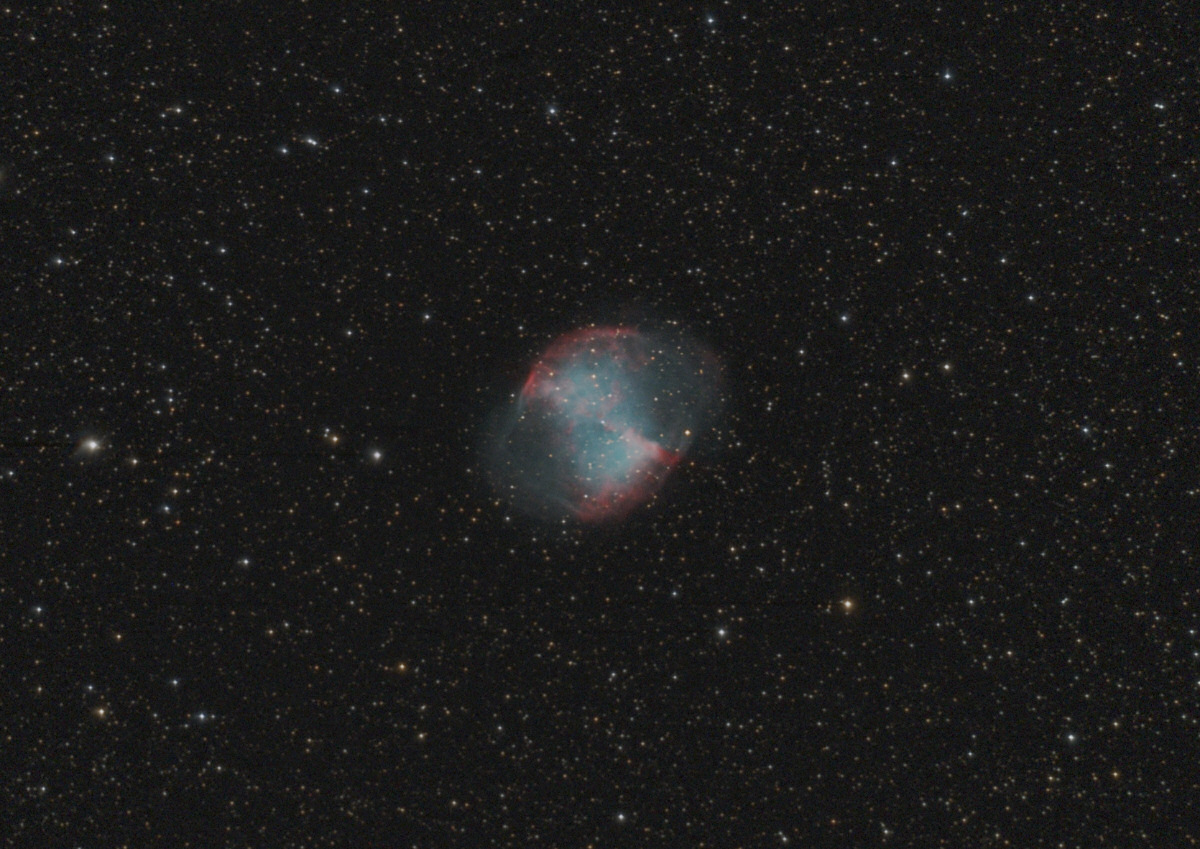
M27 is the second largest planetary nebulae in the sky and is located in Vulpecula within the northern Milky Way.
Despite their name, planetary nebulae have nothing to do with planets. They were named originally because their discoverers observed them visually and they did not appear as stellar point sources, but rather as small diffuse objects that resembled the outer planets in our solar system such as Uranus and Neptune when seen in a telescope.
Planetary nebula are shells of gas shed by stars late in their life after using up all of their nuclear fuel. The star then ejects a significant portion of its mass in a gaseous shell, which is illuminated by its extremely hot central star, which is just the core left from the original star. This a normal process for stars in a late period of their life which also our sun will undergo in a few billion years. Planetary nebulae do not last long in cosmic terms, the shell of gas expands and diffuses becoming invisible and the star turns into a white dwarf. Most planetary nebula are bipolar, meaning symmetric with respect to one axis which is thought to be the rotation axis of the original star.
M27's central star has a magnitude of 13.8. The nebula itself, which extends to 15 arcminutes in size at it's faintest extensions, is second in size only to NGC 7293, The Helix Nebula in Aquarius. The Helix has a lower surface brightness though because of its larger size.
 Vulpecula and Sagitta, zoom lens photograph.
Vulpecula and Sagitta, zoom lens photograph.
Exposure Data
Observing Hints
This object is not too difficult to find, but it is located in a densely populated region of the Milkyway where one might get lost. Starting at Altair (Alpha Aquilae), one of the stars of the summer triangle, and moving north about 10 degrees, you will find the stars of small constellation Sagitta, the most prominent star there is Delta Sagittae. Immediately to the east of Delta is already an interesting object, the globular cluster M71, a rewarding target for telescopes starting at 6", but really beautiful in a 10" or larger scope. Small telescopes will only show a nebulous spot with a few stars superimposed.
Back to starhopping to M27. Going east from Delta Sagittae, you will find Gamma Sagittae, forming the point of the arrow, this is the brightest star of Sagitta. Going 3.5 degrees straight north from Gamma you will find a star slightly brighter than those surrounding it, a chain of faint stars starting east of Gamma Sag also leads there. Immediately south of it there is M27 visible in a 7x50 finderscope as nebulous spot.
In small telescopes M27 appears as a compact nebulous speck with two well- defined round edges. A good 4" refractor will already show the faint extensions of the Dumbbell Nebula perpendicular to the sharp edges with averted vision, an UHC filter will help to see them. In 6" telescopes these extensions become easier to see, in a transparent night even without filter. With increasing aperture these extensions become more easily visible and the outline of the nebula becomes oval.
The central star of M27 has magnitude 13.8 and is visible with a quality 6" reflector in a night of steady seeing at 200-300x power. Two more stars are observable within the nebula using averted vision. Bigger telescope will show the central star more easily and the larger the aperture, the more stars become apparent superimposed on the nebula, an 18" telescope shows 9- 10 stars. However, if the seeing is bad, the central star is difficult to observe, even in an 18".
M27 is an object with high surface brightness, so even small telescope yield pleasing views at moderate magnifications. In a 6" telescope the nebula is still quite bright at 100x and even at 200x, when looking for the central star, there is some nebulosity visible. Large aperture telescopes show subtle variations in brightness within the faint extensions, depending strongly on the transparency of the night, therefore M27 is a good indicator for the quality of the sky and conditions at the observing site.
M27 looks best without filter, but under a bright moonlit sky you can work some kind of "magic trick": The Nebula won't be observable at all without filter to inexperienced observers, even experienced observers will only see it very dimly. But when you insert an OIII filter, the nebula seems to "appear from nowhere" with good contrast... ☺